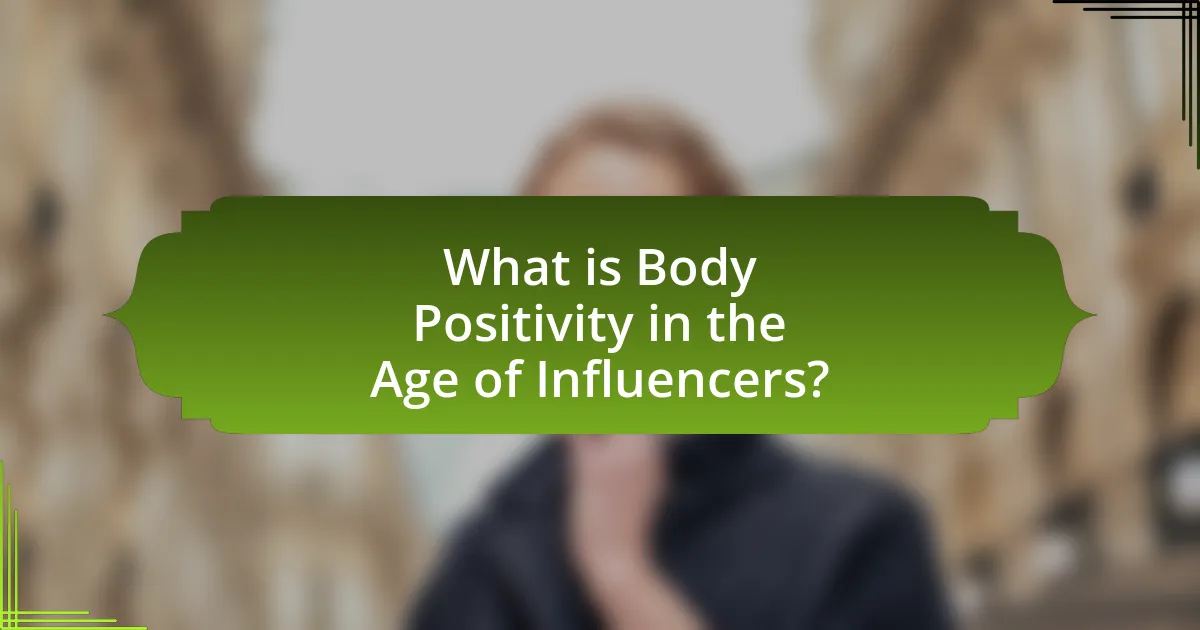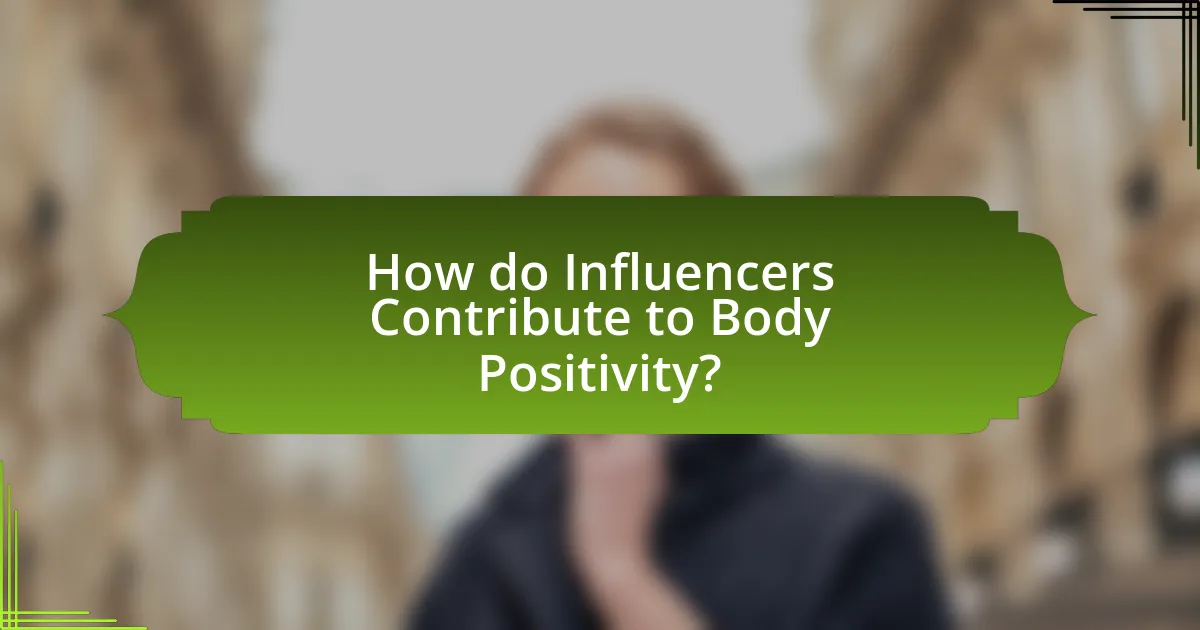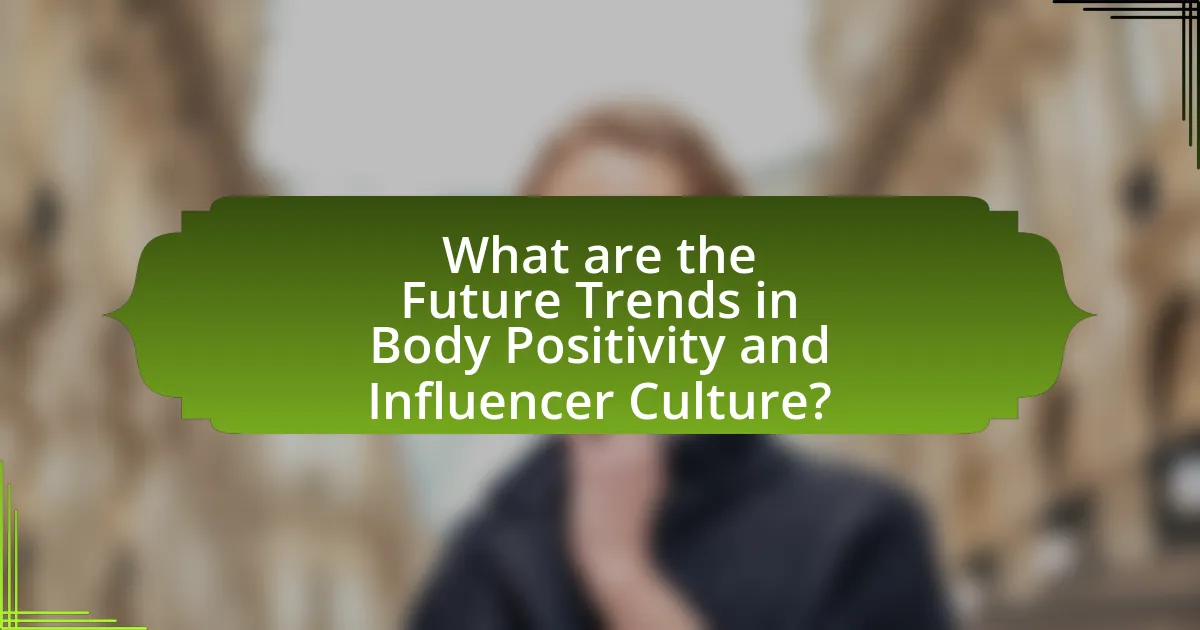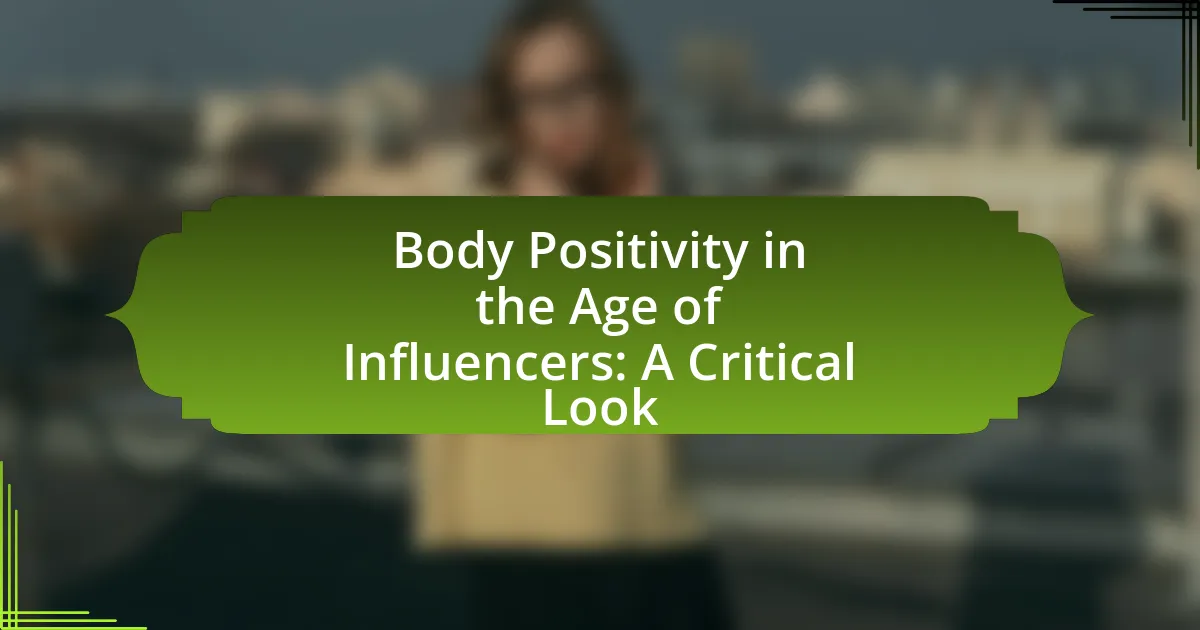Body positivity in the age of influencers is a movement advocating for the acceptance of all body types, emphasizing self-love and confidence, significantly shaped by social media. The article explores the evolution of body positivity, its historical influences, and the role of influencers in shaping perceptions of body image. It discusses the psychological benefits of body positivity, the challenges posed by unrealistic beauty standards, and the dual role of social media in promoting and hindering this movement. Additionally, it examines future trends in body positivity and influencer culture, highlighting the importance of authenticity and inclusivity in fostering a supportive environment for diverse body representations.

What is Body Positivity in the Age of Influencers?
Body positivity in the age of influencers refers to the movement advocating for acceptance of all body types, emphasizing self-love and confidence, while being significantly shaped by social media platforms. Influencers play a crucial role in this movement by promoting diverse body representations and challenging traditional beauty standards, which can lead to increased visibility and acceptance of various body shapes and sizes. Research indicates that social media can both positively and negatively impact body image; for instance, a study published in the journal “Body Image” found that exposure to body-positive content can enhance self-esteem and body satisfaction among viewers.
How has the concept of body positivity evolved with social media?
The concept of body positivity has evolved significantly with social media, transitioning from a niche movement to a mainstream dialogue. Initially, body positivity focused on challenging societal beauty standards and promoting self-acceptance among marginalized body types. However, with the rise of platforms like Instagram and TikTok, the movement has gained visibility, allowing diverse voices to share their experiences and advocate for inclusivity.
Research indicates that social media can both positively and negatively impact body image; a study published in the journal “Body Image” found that exposure to body-positive content can improve self-esteem and body satisfaction among users. Conversely, the same platforms can perpetuate unrealistic beauty ideals through influencer culture, leading to mixed messages about body acceptance. This duality illustrates how social media has become a powerful tool in shaping the narrative around body positivity, making it more accessible while also complicating its message.
What historical movements have influenced body positivity?
The body positivity movement has been significantly influenced by several historical movements, including the feminist movement, the civil rights movement, and the fat acceptance movement. The feminist movement, particularly in the 1960s and 1970s, challenged societal norms regarding women’s bodies and advocated for self-acceptance and autonomy over one’s body. The civil rights movement emphasized equality and challenged discrimination, which laid the groundwork for advocating body diversity and acceptance across different races and ethnicities. The fat acceptance movement, emerging in the late 1960s, specifically focused on combating stigma against larger bodies and promoting the idea that all body types deserve respect and dignity. These movements collectively contributed to the foundation of body positivity by promoting inclusivity, self-love, and the rejection of unrealistic beauty standards.
How do influencers shape perceptions of body image?
Influencers shape perceptions of body image by promoting specific beauty standards and lifestyles through curated content on social media platforms. Their posts often highlight idealized body types, which can lead to increased societal pressure to conform to these standards. Research indicates that exposure to influencer content correlates with body dissatisfaction among followers; for instance, a study published in the journal “Body Image” found that individuals who frequently engage with fitness influencers report lower self-esteem and higher body dissatisfaction. This demonstrates the significant impact influencers have on shaping and reinforcing societal norms regarding body image.
Why is body positivity important in today’s society?
Body positivity is important in today’s society because it promotes self-acceptance and challenges harmful beauty standards. This movement encourages individuals to embrace their bodies regardless of size, shape, or appearance, fostering mental health and well-being. Research indicates that body positivity can reduce the prevalence of eating disorders and improve self-esteem, as seen in a study published in the journal “Body Image” by Tiggermann and Slater, which found that exposure to body-positive messages significantly improved body satisfaction among participants. By advocating for diverse representations of beauty, body positivity also combats discrimination and stigma, creating a more inclusive environment for all individuals.
What psychological benefits does body positivity provide?
Body positivity provides significant psychological benefits, including enhanced self-esteem and reduced anxiety. Individuals who embrace body positivity often experience a greater sense of self-acceptance, which can lead to improved mental health outcomes. Research indicates that body positivity is associated with lower levels of body dissatisfaction and depressive symptoms. For instance, a study published in the journal “Body Image” found that individuals who engage in body-positive practices report higher self-esteem and lower levels of social comparison, which are linked to anxiety and depression. This evidence underscores the positive impact of body positivity on mental well-being.
How does body positivity impact self-esteem and mental health?
Body positivity significantly enhances self-esteem and mental health by promoting acceptance of diverse body types and reducing negative self-perception. Research indicates that individuals who embrace body positivity experience lower levels of body dissatisfaction, which is closely linked to improved mental health outcomes, including reduced anxiety and depression. A study published in the journal “Body Image” found that participants who engaged with body-positive content reported higher self-esteem and a more positive body image compared to those who did not. This correlation underscores the importance of body positivity in fostering a healthier self-view and overall psychological well-being.
What challenges does body positivity face in the influencer culture?
Body positivity faces significant challenges in influencer culture, primarily due to the prevalence of unrealistic beauty standards and the commodification of body image. Influencers often promote curated lifestyles that emphasize specific body types, which can perpetuate feelings of inadequacy among followers. Research indicates that 70% of women feel pressure to conform to beauty ideals portrayed on social media platforms, leading to negative body image and self-esteem issues. Additionally, the commercialization of body positivity by influencers can dilute its original message, transforming it into a marketing tool rather than a genuine movement for acceptance and diversity. This commercialization often prioritizes profit over authenticity, undermining the core values of body positivity.
How do unrealistic beauty standards perpetuated by influencers affect body positivity?
Unrealistic beauty standards perpetuated by influencers negatively impact body positivity by promoting unattainable ideals that can lead to body dissatisfaction among their followers. Research indicates that exposure to idealized images on social media correlates with increased levels of anxiety, depression, and low self-esteem, particularly among young women. A study published in the journal “Body Image” found that individuals who frequently engage with influencer content are more likely to compare themselves unfavorably to these curated images, which undermines their self-acceptance and body confidence. Consequently, the pervasive nature of these standards fosters a culture where body positivity is challenged, as individuals struggle to reconcile their self-image with the unrealistic portrayals they encounter online.
What role does social media play in promoting or hindering body positivity?
Social media plays a dual role in promoting and hindering body positivity. On one hand, platforms like Instagram and TikTok can foster body positivity by providing a space for diverse body representations and supportive communities, as evidenced by movements such as #BodyPositivity, which has garnered millions of posts advocating for self-acceptance and inclusivity. On the other hand, social media can also hinder body positivity by perpetuating unrealistic beauty standards through heavily edited images and influencer culture, leading to increased body dissatisfaction among users; studies indicate that exposure to idealized body images on social media correlates with negative body image and eating disorders. Thus, while social media has the potential to promote body positivity, it simultaneously poses significant challenges that can undermine this goal.

How do Influencers Contribute to Body Positivity?
Influencers contribute to body positivity by promoting diverse body types and challenging traditional beauty standards. They utilize social media platforms to share authentic representations of themselves, often showcasing unfiltered images that resonate with their audiences. For instance, studies indicate that exposure to body-positive content on platforms like Instagram can lead to improved body image among viewers, as influencers often emphasize self-acceptance and confidence. This shift in narrative helps to normalize various body shapes and sizes, fostering a more inclusive environment that encourages individuals to embrace their uniqueness.
What strategies do influencers use to promote body positivity?
Influencers promote body positivity through strategies such as sharing authentic personal stories, showcasing diverse body types, and engaging in community discussions. By sharing their own experiences with body image, influencers create relatable content that resonates with their audience, fostering a sense of connection and acceptance. Additionally, they often feature a variety of body shapes and sizes in their posts, challenging conventional beauty standards and encouraging followers to embrace their uniqueness. Engaging in discussions around body positivity, including addressing societal pressures and promoting self-love, further amplifies their message and encourages a supportive community. These strategies collectively contribute to a broader cultural shift towards acceptance and appreciation of all body types.
How do authentic representations of diverse bodies influence followers?
Authentic representations of diverse bodies positively influence followers by promoting body acceptance and reducing stigma. Research indicates that exposure to diverse body types can enhance self-esteem and body image among individuals, as seen in a study published in the journal “Body Image” by Tiggermann and Slater, which found that participants exposed to images of diverse bodies reported higher body satisfaction. This representation fosters a sense of belonging and validation, encouraging followers to embrace their own bodies and challenge societal beauty standards.
What impact do influencer campaigns have on societal norms?
Influencer campaigns significantly shape societal norms by promoting ideals and behaviors that resonate with their audiences. These campaigns often challenge traditional beauty standards, as seen in the rise of body positivity movements that encourage acceptance of diverse body types. For instance, research published in the Journal of Consumer Research indicates that exposure to body-positive influencers can lead to increased self-esteem and body satisfaction among followers. This shift in perception reflects a broader cultural acceptance of varied body images, influencing consumer behavior and societal expectations regarding beauty and health.
How can influencers balance authenticity and marketing?
Influencers can balance authenticity and marketing by selectively promoting products that align with their personal values and resonate with their audience. This approach fosters trust and maintains their genuine persona while still engaging in commercial activities. Research indicates that 86% of consumers prefer to see authentic content from influencers, which reinforces the importance of aligning marketing efforts with personal beliefs and audience expectations. By prioritizing transparency in sponsored posts and sharing personal experiences related to the products, influencers can effectively navigate the fine line between authenticity and marketing.
What ethical considerations should influencers keep in mind?
Influencers should prioritize authenticity and transparency in their content to maintain ethical standards. This includes clearly disclosing paid partnerships and sponsorships, as mandated by the Federal Trade Commission (FTC) guidelines, which require influencers to inform their audience when they are compensated for promoting products. Additionally, influencers should avoid promoting unrealistic body standards and instead embrace diverse body types, as research indicates that representation positively impacts body image and self-esteem among followers. By adhering to these ethical considerations, influencers can foster a more inclusive and responsible online environment.
How can influencers effectively engage their audience on body positivity?
Influencers can effectively engage their audience on body positivity by sharing authentic personal stories and experiences that resonate with their followers. This approach fosters a sense of community and relatability, encouraging open discussions about body image. Research indicates that personal narratives can significantly enhance emotional connection; for instance, a study published in the Journal of Social and Personal Relationships found that self-disclosure increases trust and engagement among audiences. Additionally, influencers can utilize interactive content, such as polls and Q&A sessions, to invite audience participation, further strengthening the dialogue around body positivity.

What are the Future Trends in Body Positivity and Influencer Culture?
Future trends in body positivity and influencer culture include a shift towards greater inclusivity and authenticity, as influencers increasingly embrace diverse body types and promote self-acceptance. This trend is supported by research indicating that 67% of consumers prefer brands that represent a variety of body shapes and sizes, reflecting a growing demand for representation in media. Additionally, the rise of platforms prioritizing mental health and well-being suggests that influencers will focus more on promoting positive body image and self-love, rather than unattainable beauty standards. This evolution is further evidenced by campaigns like #BodyPositivity gaining traction, which encourage individuals to celebrate their bodies, thus reshaping influencer marketing strategies to align with these values.
How is the body positivity movement expected to evolve?
The body positivity movement is expected to evolve towards greater inclusivity and intersectionality, addressing diverse body types, abilities, and identities. As social media continues to amplify various voices, the movement will likely incorporate a broader range of experiences, moving beyond traditional beauty standards. Research indicates that campaigns featuring diverse representations can lead to increased self-esteem and acceptance among individuals of all backgrounds. For instance, a study published in the journal “Body Image” found that exposure to diverse body types positively influenced body satisfaction among participants. This evolution will also likely involve a critical examination of the commercialization of body positivity, as influencers and brands navigate the balance between authenticity and profit.
What emerging platforms are shaping the future of body positivity?
Emerging platforms shaping the future of body positivity include TikTok, Instagram, and specialized apps like Body Positive and The Curvy Fashionista. TikTok has gained prominence due to its algorithm that promotes diverse body types and encourages users to share personal stories, fostering a community around body acceptance. Instagram continues to be influential with campaigns like #BodyPositivity and #EffYourBeautyStandards, which challenge traditional beauty norms. Additionally, apps like Body Positive provide resources and support for individuals seeking to embrace their bodies, while The Curvy Fashionista focuses on fashion for plus-size individuals, promoting inclusivity in the fashion industry. These platforms collectively contribute to a cultural shift towards body acceptance and diversity.
How can influencers adapt to changing societal expectations?
Influencers can adapt to changing societal expectations by actively promoting body positivity and inclusivity in their content. This adaptation involves embracing diverse body types, challenging traditional beauty standards, and engaging with their audience on issues related to self-acceptance. Research indicates that 67% of consumers prefer brands that promote body positivity, highlighting the importance of aligning content with societal values. By incorporating authentic narratives and showcasing real-life experiences, influencers can foster a supportive community that resonates with evolving societal norms.
What practical steps can individuals take to promote body positivity?
Individuals can promote body positivity by actively challenging societal beauty standards and embracing diverse body types. This can be achieved through sharing positive affirmations on social media, participating in body-positive campaigns, and supporting brands that celebrate inclusivity. Research indicates that exposure to diverse body representations can improve self-esteem and body image among individuals (Tiggemann & Slater, 2014, Body Image). By fostering a community that values all body shapes and sizes, individuals contribute to a cultural shift towards acceptance and appreciation of body diversity.
How can followers support body-positive influencers effectively?
Followers can support body-positive influencers effectively by actively engaging with their content through likes, shares, and positive comments. This engagement not only boosts the visibility of the influencers’ messages but also fosters a supportive community that encourages body acceptance. Research indicates that social media interactions can significantly enhance the reach and impact of body-positive campaigns, as seen in studies showing that posts with higher engagement rates receive more attention and can influence followers’ perceptions of body image.
What personal practices can enhance body positivity in daily life?
Practicing self-acceptance and gratitude can significantly enhance body positivity in daily life. Engaging in daily affirmations that focus on appreciating one’s body and its capabilities fosters a positive self-image. Research indicates that individuals who regularly practice gratitude report higher levels of well-being and self-esteem, which are crucial for body positivity. Additionally, surrounding oneself with supportive and body-positive communities, both online and offline, reinforces a healthy self-view and counters negative societal messages.



